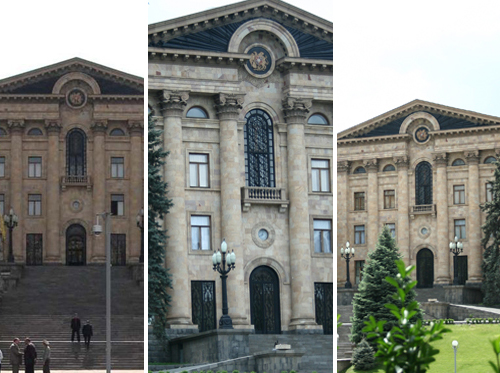Elections to the National Assembly of the Republic of Armenia of the second convocation were held on 30 May 1999. In comparison with 1995 elections, the number of deputies was reduced from 190 to 131 (75 under majority and 56- under proportional vote system).
21 parties and several blocs took part in elections. Six parties and 2 blocs passed the 5% threshold- “Unity” bloc -41,69% (29 parliament members), the Communist Party- 12,09% (8 parliament members), “Rights and Unity” bloc -7,96% (6 parliament members), Dashnaktsutyun – 7,86% (5 parliament members), “Orinats Yerkir” – 5,28% (4 parliament members), the National Democratic Union – 5,17% (4 parliament members). 53 out of 129 deputies belonged to neither party.
There were 6 factions and 3 deputy groups in the National Assembly of the second convocation: the factions of “Unity” (46 parliament members), “Communist Party of Armenia” (8 parliament members), Dashnaktsutyun (8 deputies parliament members “Rights and Unity” (5 parliament members), “Orinats Yerkir (4 parliament members), “National Democratic Union” (4 parliament members) and the following deputy groups: the “Agrarian Industrial Democratic Union” (11 parliament members, prior to that “Stability”), “Armenia” (12 parliament members) and “People’s Deputy” (6 parliament members).
Photo: Photolure
Karen Demirchyan was elected the Chairman of the Armenian National Assembly of the second convocation. Albert Bazeyan (who was later replaced by Yuri Bakhshyan) and Ruben Miroyan were appointed deputy speakers.
Scandals
The election campaign was on the whole calm and there were no scandals during it. There was only one extraordinary incident - the assault against candidate Shant Harutyunyan.
Sensation
The main sensation was certainly the decision to form “Unity” election bloc between the Republican Party of Armenia (RPA) headed by Vazgen Sargsyan and the People’s Party of Armenia (PPA) headed by Karen Demirchyan.
Photo: Photolure
Karen Demirchyan lost 1998 presidential elections to Robert Kocharyan, and although he didn’t dispute the election outcome publicly, the former Communist leader of Armenia was in “deep opposition” to authorities.
On 30 May 1999, RPA representative Yuri Bakhshyan officially informed that the unification of RPA and PPA became a reality. The list of “Unity” bloc comprised 145 names. It was headed by Karen Demirchyan, Vazgen Sargsyan, president of the National Academy of Sciences Fadey Sargsyan, formal RPA leader Andranik Margaryan and vice speaker Albert Bazeyan.
Vazgen Sargsyan: The common pain unites us with Karen Demirchyan…
“Both parties are in the making. The two leaders will play a decisive role in this process. The decision to form a union was not an easy one for me and Karen Demirchyan. Armenia is a country of one idea. We are different people, our visions often differ but the common pain unites us…
Photo: Photolure
Yes, we were on opposite sides of the barricades, but these were not hostile barricades. We were guided by the same pain which we feel today. There was a healthy competition between us and I wish the same to everyone. This union was and will be formed: there are “healthy” reasons for that, the goals are clear and common,” Vazgen Sargsyan said in an interview to “Hayastani Hanrapetutyun” on 18 May, 1999.
Election period
The creation of such a powerful union of two most significant figures on Armenia’s political field immediately changed the state of affairs. Few people doubted that the “Unity” will gain the majority of mandates in the parliament.
“Many people thought this union was a misalliance, but in vain. Even the official data said that Karen Demirchyan, who entered the fight for the post of the President at extraordinary elections in March 1998 without any preparatory work and promotion campaign, gained 40% of votes. According to non-official data, he defeated Robert Kocharyan right in the first tour bur the victory was taken away from him. Informed people claim that Vazgen Sargsyan, who facilitated the falsification of election results, began to seriously think about the possible perspectives of cooperation right after that. It was very tempting to fortify his own ambitions by Demirchyan’s unfading charisma. But the union with the young Defense Minister would be very beneficial for Karen Demirchyan too. The 67-year-old leader of people’s sympathies perfectly realized: he can win in every conceivable voting, but nobody will ever give him legitimate victory unless he had a real power behind him,” the Russian “Nezavisimaya Gazeta” [Independent Newspaper] wrote then.
Commenting on the creation of the alliance between Vazgen Sargsyan and Karen Demirchyan, representatives of the Communist Party of Armenia noted then that the formation of the bloc will bring them additional votes, since the voters have got rid of the illusions of Karen Demirchyan’s communist past.
Photo: Photolure
Dashnaktsutyun took a neutral position. In particular, in an interview to “Golos Armenii”[Armenia’s Voice] paper, Vahan Hovhannisyan said that “the alliance itself could be even beneficial: in any case, the political squabble won’t be hideous.”
Anna Israelyan, Chief Editor of “Aravot” daily’s online version: People greeted Karen Demirchyan and Vazgen Sargsyan with genuine enthusiasm
The elections of 1999 were the most disgraceful from the point of view of election lists. We are making “revelations” today: for example the name of Fadey Sargsyan was still in the voter lists or 100 people can be registered in one apartment. But, I can assure you that all this is nothing compared with what was done with the election lists in 1999.
About the unification of Karen Demirchyan and Vazgen Sargsyan
The unification was really a big surprise. On the whole, Karen Demirchyan was a very unpredictable political figure in this sense. But at the same time, there were rumors that the game rules were agreed upon with the authorities. I remember that Vazgen Manukyan expressed doubts that Karen Demirchyan returned to politics to oppose him. The fact that a year after presidential elections the opposition candidate, who had taken the second place, agrees to conclude a union with one of the pillars of the ruling regime, was also considered to be within the logic of agreements. I can’t say whether it was indeed so or not.
As for Vazgen Sargsyan’s logic, I will have to remember a hypothesis about contradictions inside the ruling regime, which was frequently voiced at that time. No matter how much Vazgen Sargsyan assured that there “were no problems” between him and Kocharyan, this step testified the opposite.
Whatever it was, people welcomed Karen Demirchyan and Vazgen Sargsyan with true enthusiasm, especially in regions and villages. It seems ridiculous today, but meeting Karen Demirchyan people used to say: “look I still wear the suit I had bout during your times.” People indeed had good memories about soviet times and naively believed that one man could change everything…
Assessments of observers
The OSCE/ODIHR Mission comprised of 12 long-term, 168 short-term observers and 24 OSCE PA members stated that parliamentary elections in Armenia, in general, became a step towards the fulfillment of Armenia’s commitments within OSCE.
Photo: Photolure
The report said that freedom of assembly and freedom of speech were respected, parties which were banned earlier were allowed to enter the political arena, the coverage of political parties on governmental TVs and other media outlets were balanced and neutral, and the election campaign was calm, without serious violations. At the same time, the report said that the programs of all parties were the same, and the fight was mainly between personalities rather ran political platforms.
“Although the election process in Armenia in 1999 showed obvious improvements as compared to 1995, 1996, and 1998 elections which were accompanied with significant violations, previous elections are not an adequate basis for making comparisons. The only criterion is the OSCE commitments reflected in the Copenhagen Document of 1990. More improvements need to be done in this regard,” OSCE observers stated then, adding that many serious problems still remained unresolved.
Photo: Photolure
The representative of the U.S. Department of State James Foley stated that parliamentary elections in Armenia showed improvements as compared to previous ones, however the country should take urgent measures to reform the election system to eliminate the shortcomings revealed by the observers.
Hopes shot down
Unfortunately, the main event of 1999 was not the election but the terrorist act committed on 27 October 1999, whose executors decapitated the “Unity” bloc and instantly dashed many hopes, dropping Armenia back to many years.
Conclusion
The National Assembly of the Republic of Armenia of the second convocation began its work on June 10, 1999 and completed on May 14, 2003. After the October 27th terrorist act, a new leadership of the National Assembly was elected at an extraordinary session on November 2, 1999. Armen Khachatryan was elected National Assembly Chairman, Tigran Torosyan and Gagik Aslanyan were appointed deputy chairman.
Read about 1995 elections here.
Read about 2007 elections on our website next week.
Aram Araratyan

















Comments
Dear visitors, You can place your opinion on the material using your Facebook account. Please, be polite and follow our simple rules: you are not allowed to make off - topic comments, place advertisements, use abusive and filthy language. The editorial staff reserves the right to moderate and delete comments in case of breach of the rules.